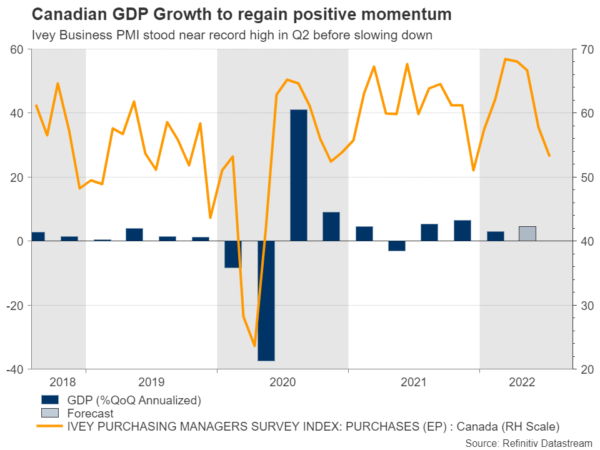Canada will report GDP data for the second quarter on Wednesday at 12:30 GMT as investors largely expect a bold rate increase in September. The figures will follow another depressing week for the loonie versus the US dollar, but even if they are arrive encouraging, they may not be able to provide a strong helping hand to the currency. The US nonfarm payrolls report due on Friday and next week’s OPEC meeting will be the next highlights in the calendar.
Canada to report stronger GDP figures in Q2
The Canadian economy has likely regained positive momentum during the second quarter, with analysts estimating an annualized expansion of 4.5% (quarter-over-quarter) compared to 3.1% registered in the first three months of the year. The monthly reading for June is also expected to show a negligible improvement, inching to 0.1% from no growth previously.
There is plenty of data to support a potential pickup in Canadian activity during the aforementioned period. On the supply side, the Ivey business PMI remained elevated close to its March record high, while exports continued to grow faster than imports, boosting the trade surplus to the highest in 14 years. Given that Canada largely depends on energy exports, higher oil prices have likely generated more revenue for businesses, putting the economy in a better place than the US.
On the demand side, consumption was contributive too. With the unemployment rate pinned at record lows, retail sales marked six months in the expansion area from March onwards, while the continuous growth in housing starts and home prices reflected increasing appetite for spending despite the rising interest rates and the burdening household debt.
BoC may stay aggressive
Hence, although the recession risk has become more real than a statistical probability in the face of the Ukrainian war, the covid infections, as well as the climate change, which have further worsened supply jitters, the Bank of Canada may follow the Fed’s footsteps and not give up monetary tightening until it sees a sustainable decline in inflation. Besides, it’s either allowing inflation to destroy the economy itself and become entrenched, or pressing the economy through higher interest rates anyway to stabilize prices. Apparently, policymakers have chosen the second option and will not allow inflation to dominate without a fight, even if the 10-year bond yields have slumped below the 2-year yields recently, flagging that a potential economic downturn is nearing. Futures markets are currently providing a 68.7% probability for a 75 bps rate hike in September after July’s surprising super-sized 100bps increase.
Loonie may shrug off GDP data; NFP & OPEC meeting more important
Turning to FX markets, the loonie faces a difficult time in competing with the US dollar as the Fed is slightly ahead of the BoC in terms of rate increases, while falling oil prices have been acting against the oil-dependent currency since mid-June. Unless GDP growth surprises significantly to the upside, the loonie may not respond to the data given that some indicators such as the employment growth have been trending downwards so far in the third quarter, feeding speculation that the next GDP release might be less rosy.
The all-important US nonfarm payrolls could steal the show at the end of the week as well, potentially causing larger volatility in dollar/loonie than the Canadian GDP. Meanwhile, traders will look for any OPEC headlines ahead of Monday’s meeting, especially after Saudi Arabia opened the case of a sudden output cut.
The largest oil producer complained about thin liquidity in oil markets to justify a potential reduction. Perhaps it wants more oil producers to invest in the oil field and hedge their production to keep up with demand or simply it prefers higher oil prices. Otherwise, it does not look like anything more than another political game against the US. Recall that US president Biden has recently visited Saudi Arabia to negotiate a higher supply, but the Saudi prince has been resisting such a request. Now the US aims to revive the Iranian nuclear deal as an alternative method to boost oil production, but that will probably make the Saudis unhappy as relations with Iran have been intense since the attack on the Saudi embassy in Tehran in 2016. Saudi Arabia has also been a long hater of Iran’s nuclear programs.
In any case, any rumors that a supply cut from OPEC could happen as soon as next week may revive the rally in oil prices, helping the loonie to recover some lost ground.
USD/CAD levels to watch
In the meantime, the resistance around the 200-weekly simple moving average (SMA) at 1.3026 per US dollar is still adding some footing under the loonie. If that barrier breaks, dollar/loonie may again re-challenge the 1.3077 bar ahead of the 1.3120 handle. Higher, the door would finally open for the 20-month high of 1.3222.
Alternatively, stronger-than-expected GDP figures combined with a not-so-great NFP report could press the pair towards the tentative support trendline at 1.2963. Moving lower, the price may stabilize near its 20- and 50-day SMAs seen near 1.2900. If that base cracks as well, then the sell-off may speed up towards the 1.2800 psychological level.















